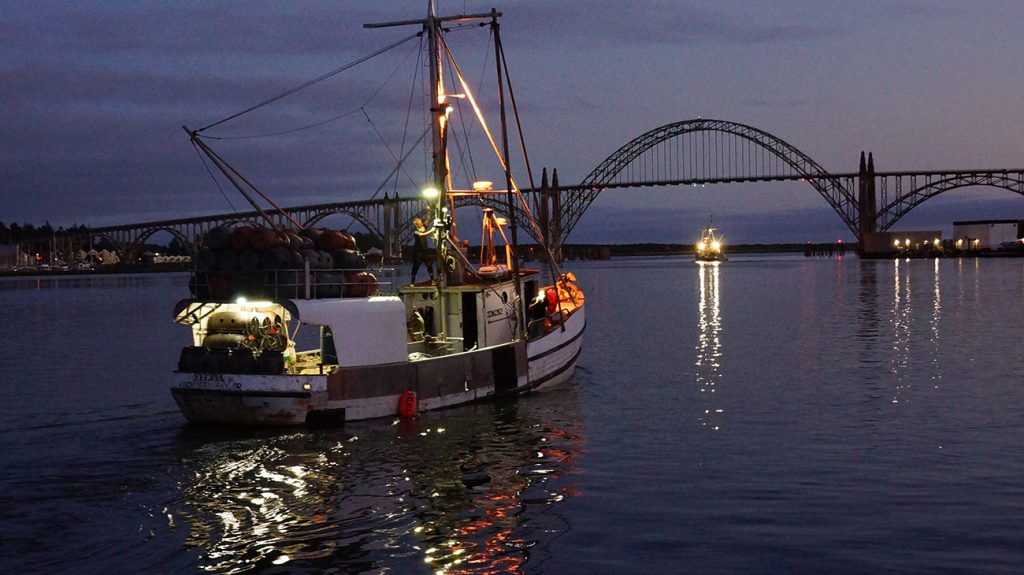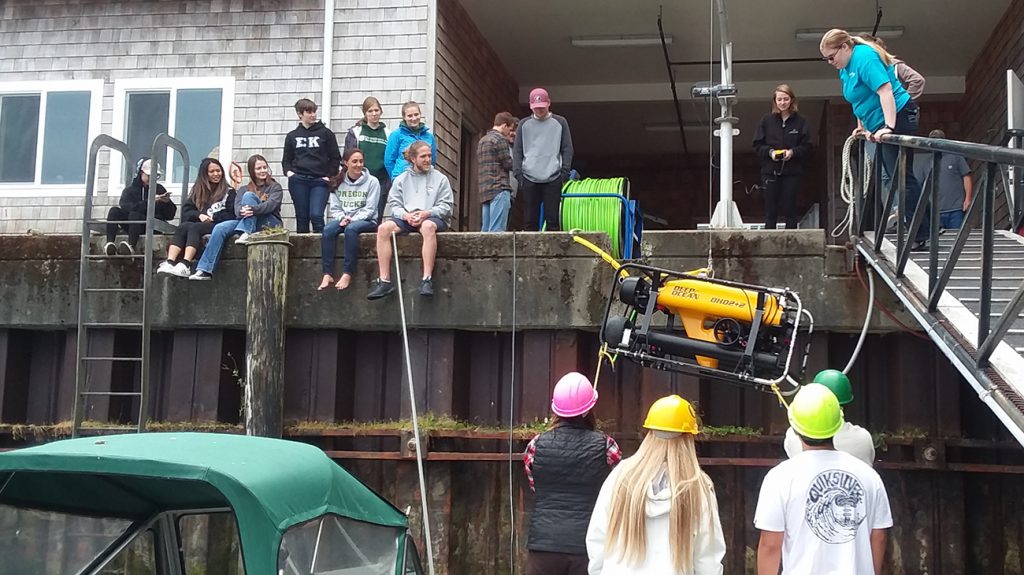From lingcod life histories and juvenile Dungeness crab genetics, to coralline algae signaling and sea star wasting disease – student research provides invaluable contributions to nearshore ocean and marine reserves science. The ODFW Marine Reserves Program supports student projects through funding, fieldwork, or data sharing, and they in turn help us meet one of the goals of the ODFW Marine Reserves Program – advancing our knowledge about the nearshore environment.
ODFW marine reserves researchers work with graduate students in numerous ways to advance what we know about the creatures in Oregon’s nearshore ocean. Each post below was written by students themselves, to describe their work, and share why their research is so cool.
Dungeness Crab Genetics

“Hi, I’m Liz, and I’m a fisheries genetics student at Hatfield Marine Science Center studying the genomic diversity of young Dungeness crab (megalopea stage), the most valuable single-species commercial fishery in Oregon. The aim of my research is to use genomic approaches to gain a better understand how ocean conditions influence larval dispersal and, ultimately, the genetic connectivity of this species along our coasts.” – Liz Lee, Oregon State University
***
Lingcod Diets

“My name is Bonnie Brown and I’m a graduate student at Moss Landing Marine Labs. I’m studying the diet of lingcod. Why study diets? Well, knowing what and how much a predator is eating helps fill in data gaps in food web structures. This is of particular interest for a top predator in the rockyreef ecosystem, such as the Lingcod. They consume a wide variety of prey, from cephalopods and crustaceans to an assortment of fishes, and even other Lingcod! Why study Lingcod? Not only are they important for the commercial and recreational fisheries, but also they are really cool fish! They can weigh over 80lbs and reach over 60 inches in length (source: ADFG). This is a collaborative project that took place in Alaska, Washington, Oregon, and California. We had lots of help from multiple resource agencies and academic institutions, captains and deckhands, and many volunteer anglers.” – Bonnie Brown, Moss Landing Marine Lab
***
Urchin Diets

“I’m Sara Hamilton, and I study what urchins eat by looking at the chemical composition of their reproductive organs. Much like how a doctor might tell if a patient is a vegan by examining the amount of saturated fats in their body, we can tell what kinds of algae urchins are eating by looking at the fats they store in these organs. This work will help us better understand what role urchins play in Oregon’s nearshore foodwebs.” – Sara Hamilton, Oregon State University
***
Canary Rockfish Reproduction

“Hi, I’m Rachel Brooks and I am a graduate student at Moss Landing Marine Laboratories. My thesis research explores Canary Rockfish growth and reproduction along the U.S West Coast. Canary Rockfish are among a group of long-lived, late to mature rockfishes that can live to at least 84 years old! I’ve been working collaboratively with captains, deckhands and volunteer anglers to collect Canary Rockfish from various locations along the coast between Washington and Southern California. Through understanding the spatial variability in how Canary Rockfish grow and mature, this project can help resource managers better manage fisheries that catch this species.” – Rachel Brooks, Moss Landing Marine Lab
***
Cabezon Research

“Hi! My name is Megan Wilson and I’m a graduate student at Oregon State University in the Plankton Ecology Lab. I work with Cabezon, a commercially and recreationally harvested nearshore groundfish that lives right off the Oregon Coast – and can grow to be ~3ft! Cabezon begin their lives as small larvae (as big as pepper kernels, pictured) adrift in the open ocean. They endure a treacherous early life – riddled with attacks from other tiny predators in their quest to find food, grow, and eventually find their way back to a nearshore rocky reef to call home. I study Cabezon at all stages of their life cycle to understand who is surviving this perilous journey and why. With this information, I hope to improve our understanding of the environmental conditions that are most important to the survival of young Cabezon and thus in sustaining a healthy adult population. One of the life stages I study (pictured) are caught in SMURFs – collection devices resembling good habitat for young Cabezon – which are monitored by ODFW’s Marine Reserves team and OSU students.” – Megan Wilson, Oregon State University
***
Human Dimensions & Fisher Perspectives

“Hello! My name is Madison Bristol, and I am majoring in both Environmental Science (BS) and Dance (BA) at the University of Washington. This summer I was an Oregon Sea Grant Summer Scholar with the ODFW’s Marine Reserves Program. Instead of doing ecological research, I worked in the Human Dimensions Project and interviewed fishers about their perspectives on Oregon’s marine reserves. Commercial and charter fishers are potentially affected by the reserves on an economic and social level. They have valuable knowledge about how marine resources should be managed. I traveled a thousand miles this summer to capture their individual stories, which hopefully will help inform future marine policy and management decisions.” – Madison Bristol, University of Washington
***
Juvenile Rockfish

“Hi! My name is Will Fennie and I am a graduate student at Oregon State University. I work under Dr. Su Sponaugle in the Plankton Ecology Lab, and team up with ODFW’s Marine Reserves team to study the fascinating lives of young rockfish. Rockfish (genus Sebastes – which means magnificent) give birth to live young that are only 0.2 inches long. These tiny fish drift along with ocean currents for 2-6 months before they are big enough to swim back to coastal habitats. During this drifting phase, young rockfish must find enough food to grow and avoid the many predators looking to eat them. I am really curious about how changes in ocean conditions can affect the growth and survival of these young rockfish. Rockfish, like all bony fishes, have ear stones (otoliths) that can be read in the same way as tree rings to determine age and growth rates. Using otoliths from young rockfish collected in 2011-2018 I hope to shed some light on how changing ocean conditions affect rockfish growth and whether this leads to changes in survival. This information will improve our ability to predict how future ocean conditions will affect these magnificent fishes.” – Will Fennie, Oregon State University
***
Fish & Habitat Associations

“Hi, I’m Jackie and I study Natural Resources, GIS and Fisheries Management at Oregon State University. I’ve been working with the Oregon Marine Reserves Program to assess the use of longline fishing data as a method to understand fish, habitat associations. With the help of spatially derived habitat data, we can model what natural features and weather conditions influence where fish species live. This will be useful for learning more about the species we fish, and also help focus research efforts on a species by species basis! It’s been a blast working with the Marine Reserves Program. What a great experience.” – Jackie Dixon, Oregon State University
***
Lingcod Life History

“Hi, I’m Laurel, a grad student from Moss Landing Marine Labs. I’m investigating Lingcod life-history along the U.S. West Coast. We’ve been fishing for Lingcod from San Diego to Alaska to see how their growth, maturity, and mortality rates change by latitude. We’re interested in studying Lingcod life-history variations along the coast to see how management of nearshore fishes can be improved with the addition of this region-specific information. For example, if we know that fish grow faster up in Oregon than they do in southern California, it tells us that the regulations and legal size limits should be different between these regions as well.” – Laurel Lam, Moss Landing Marine Lab
***
Seastar Wasting Disease

“Hi, I’m Jenna Sullivan from Oregon State University and I study communities of animals that live in the intertidal zone in Oregon. I research what is happening to these communities after seastar wasting disease. That would be like figuring out what would happen to the animals that live in the savannah if lion populations crashed. In this photo, I’m surveying the intertidal looking for changes in the communities of seastar prey, such as barnacles and mussels. One change we have noticed is an increase in baby seastars. These baby seastars are between 0 and 2 years old, and we have seen unprecedented numbers of them in the intertidal. Figuring out why that happened will help us understand how populations can rebound after a disease.” – Jenna Sullivan, Oregon State University
***
Invertebrate Biodiversity

“We are a group of 17 undergraduate marine biology majors at the University of Oregon who just completed an intensive hands-on course in subtidal and deep-sea biology taught by Dr. Craig Young and Dr. Cynthia Trowbridge. We had an opportunity to collect deep-sea animals from an oceanographic ship, snorkel in nearshore kelp beds, dredge animals from the Oregon Continental shelf, and drive a remotely operated undersea vehicle. Our main assignment was a collaboration with the ODFW Marine Reserves team in which we evaluated underwater video footage and used statistical techniques to characterize the diversity of invertebrate life in the marine reserves. We hope our work will help to establish baselines for future monitoring efforts in the reserves.” – Oregon Institute of Marine Biology Students
***
Coralline Algae Signaling

“Hi, I’m Heather and I study interactions between seaweeds and invertebrates along the Oregon coast. My research focuses on crustose coralline algae, which are the bubble gum pink rocky crusts that you can find in the low intertidal. These algae play an important role in signaling animals such as abalone, chitons, and urchins to transform from free-floating planktonic juveniles to the colorful adults that we find on the rocks. The lives of these invertebrates and algae are known to be affected by ocean acidifcation, but we don’t yet know how the relationships between these species will change. I will be studying those relationships at Hatfield Marine Science Center thanks to ODFW’s Marine Reserve Program Scholarship.” – Heather Fulton, Oregon State University
If you enjoyed this story, you may also enjoy these:
